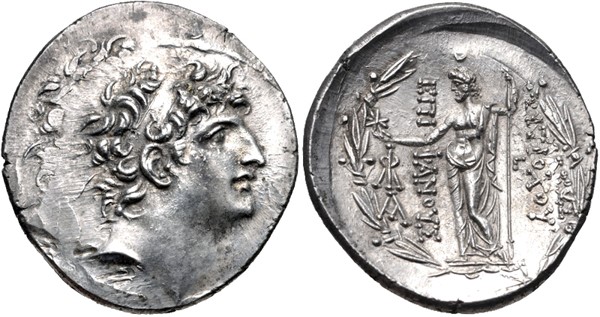112 BCE - 110 BCE | ANTIOXOY - EΠI/ΦANOYΣ,
Overstriking coin
Antiochus VIII on Seleucid - Classical Numismatic Group, E-Auction 378, 13 July 2016, 231.jpg
[1]
|
|
Sale(s)Sale(s) ᵖ:
|
Classical Numismatic Group, E-Auction 378, 13 July 2016, 231
|
|
|
|
Description
| ObverseInscription or printing placed on the obverse.:
|
Diademed head r.
|
ReverseInscription or printing placed on the reverse.:
|
ANTIOXOY - EΠI/ΦANOYΣ, (Greek) Zeus Ouranios standing left, to outer left, monogram above A, Γ to inner right, all within laurel wreath
|
Mint and issuing power
Chronology
| FromIdentifies the initial date in a range assigned in a numismatic context. 112 BCE toIdentifies the final date in a range assigned in a numismatic context.. 110 BCE
|
Hellenistic 323-30 BC  periodTime period of the numismatic object. periodTime period of the numismatic object.
|
Physical description
MetalThe physical material (usually metal) from which an object is made.: Silver 
|
WeightWeight of the numismatic object (in grams). in grams: 15.3215.32 g <br />15,320 mg <br />
|
DenominationTerm indicating the value of a numismatic object. Examples: tetradrachm, chalkous, denarius.: tetradrachm 
|
AxisDescribes the directional relationship between the obverse and reverse of a numismatic object.: 1212 mm <br />1.2 cm <br />
|
| DiameterDescribes diameter of an object (in mm).: 3131 mm <br />3.1 cm <br />
|
StandardStandard.: Attic
|
References
Description
| ObverseInscription or printing placed on the obverse.:
|
|
ReverseInscription or printing placed on the reverse.:
|
|
Mint and issuing power
Chronology
| FromIdentifies the initial date in a range assigned in a numismatic context. toIdentifies the final date in a range assigned in a numismatic context..
|
periodTime period of the numismatic object.
|
Physical description
| DenominationTerm indicating the value of a numismatic object. Examples: tetradrachm, chalkous, denarius. ᵖ:
|
tetradrachm 
|
StandardStandard. ᵖ:
|
Attic
|
References
References
- ^ Houghton, Arthur - Lorber, Catharine (2002), Seleucid coins : a comprehensive catalogue. Part 1, Seleucus I through Antiochus III, New York - Lancaster - London, 2 v. (xxxviii, 488 p. + 300 p.), 101 pl.
- ^ Hoover, Oliver D. (2009), Handbook of ancient Syrian coins : royal and civic issues, fourth to first centuries BC, The Handbook of Greek Coinage 9, Lancaster, lxix, 332 p.

